How to Grow Parsley
- March 25, 2024
- 0 comment
How to Grow Parsley dives into cultivating this beloved biennial herb, celebrated not only for its culinary versatility and vibrant flavor but also for its nutritional value. Parsley, more than a simple garnish, enriches dishes with its fresh taste and decorative touch. This guide is designed for gardeners at all levels, from experienced hands to budding enthusiasts, illustrating the rewarding process of growing parsley. Whether you aim to adorn your meals with homegrown herbs or to enrich your diet with its vitamins and minerals, this guide will walk you through the steps to successfully cultivate parsley in your garden or on your windowsill, bringing the essence of fresh herbs right to your table
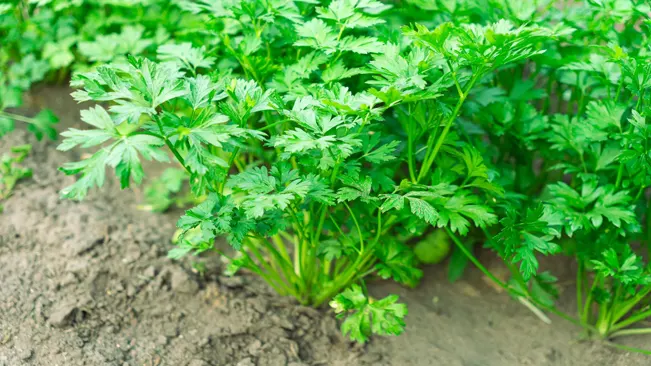
Parsley Benefits
| Benefit | Description |
|---|---|
| Nutrient-Rich | Parsley is loaded with vitamins A, C, and K, and includes iron, calcium, and magnesium. |
| Antioxidant Properties | Contains flavonoids like luteolin and apigenin, which help combat oxidative stress in the body. |
| Supports Heart Health | High in folic acid, which is essential for heart health and preventing certain cardiovascular diseases. |
| Enhances Immune Function | Vitamin C and A in parsley strengthen the immune system. |
| Promotes Healthy Kidney Function | Acts as a natural diuretic, helping to flush out excess fluid from the body, beneficial for kidney health. |
| Aids in Digestion | The high fiber content helps in digestion and maintaining a healthy gut. |
| Anti-Inflammatory Properties | Contains compounds that may reduce inflammation, beneficial for inflammatory diseases. |
| Supports Bone Health | High vitamin K content is vital for maintaining bone density and health. |
| Freshens Breath | Chewing parsley can help freshen breath due to its high chlorophyll content. |
| Potentially Cancer-Fighting | Some studies suggest that the antioxidants and other compounds in parsley may have cancer-fighting properties. |
List on How to Grow Parsley
- Choosing Your Variety
- Planting Parsley
- Caring for Your Parsley
- Pest and Disease Management
- Harvesting and Storage
- Common Challenges
Choosing Your Variety
Parsley comes primarily in two varieties – flat-leaf (Italian) and curly (French). While both are similar in taste, flat-leaf parsley is often preferred for its robust flavor and is easier to chop. Curly parsley, with its ruffled edges, adds a decorative touch and a slightly milder taste.
Flat-Leaf (Italian) Parsley
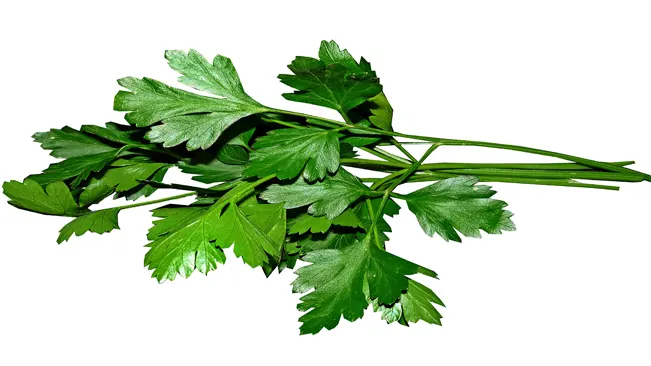
- Flavor Profile: It has a more intense and robust flavor compared to curly parsley. This makes it a favorite in culinary uses, particularly in Mediterranean, Middle Eastern, and European cuisines.
- Texture and Appearance: The leaves are flat and larger than curly parsley, which makes them easier to clean and chop. This variety is often preferred for cooking, as it integrates well into dishes without overpowering them.
- Growing Characteristics: Flat-leaf parsley tends to be more tolerant of hot weather and less prone to wilting than curly parsley. It also germinates more quickly and is generally considered easier to grow from seed.
- Culinary Uses: Ideal for pesto, chimichurri, and garnishing hearty dishes like stews, soups, and pasta.
Curly (French) Parsley
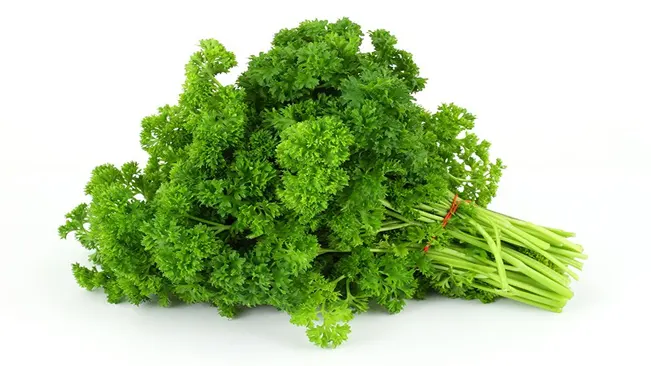
- Flavor Profile: It has a milder taste than flat-leaf parsley, with a slightly grassy and fresh flavor. This makes it excellent for more delicate culinary uses.
- Texture and Appearance: Characterized by its bright green, ruffled leaves, curly parsley is visually appealing and often used as a garnish to add a splash of color to plates.
- Growing Characteristics: It prefers cooler temperatures and can be a bit more challenging to grow from seed due to slower germination. It’s also more sensitive to hot weather.
- Culinary Uses: Often used as a garnish due to its decorative appearance. It’s also great in salads, as a topping for lighter dishes, or incorporated into dressings and dips.
Choosing Between the Two
- Personal Preference: Your choice might depend on what you’re cooking or your taste preference. If you prefer a stronger, more pronounced parsley flavor, go with flat-leaf. For a garnish or milder flavor, choose curly.
- Growing Conditions: Consider your local climate and gardening space. If you have hotter weather, flat-leaf might be more resilient. For cooler climates, either can work well.
- Culinary Needs: If you’re into cooking dishes that require a lot of herbs, like Italian or Middle Eastern cuisine, flat-leaf could be more suitable. If you’re more into garnishing and salads, curly parsley might be your choice.
Planting Parsley
Timing for Planting Parsley

- Indoor Planting: Sowing seeds indoors is a great start, especially in regions with shorter growing seasons. By starting 6-8 weeks before the last frost, you give the parsley a head start, protecting it from any late cold snaps.
- Outdoor Planting: If you prefer to sow directly outside, choose early spring or fall. This is crucial because parsley seeds can germinate in cooler soil, and the plant enjoys cooler growing conditions. In warmer climates, fall planting can be particularly beneficial, as it allows the parsley to grow throughout the winter.
Choosing the Right Soil and Sunlight

- Soil Quality: Well-draining soil is essential for parsley, as it prevents waterlogging, which can lead to root rot. Incorporating organic matter like compost can improve soil texture and fertility.
- Soil pH: Aim for a pH between 6.0 and 7.0. This slightly acidic to neutral range is ideal for most herbs, including parsley. You can easily test your soil pH with a kit from a garden center.
- Sunlight Requirements: Parsley can grow in full sun or partial shade. In regions with intense sunlight, a bit of afternoon shade is beneficial to prevent the plant from wilting.
Sowing Parsley Seeds
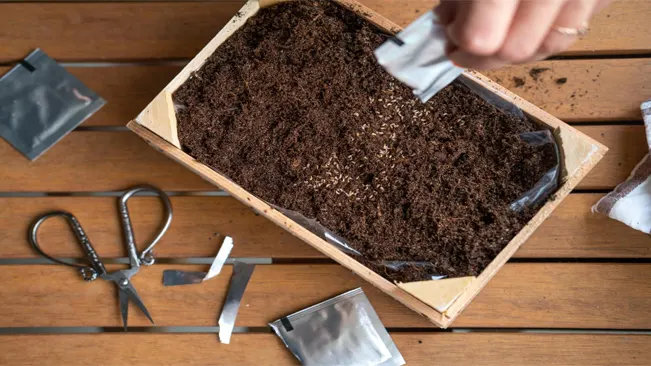
- Preparation: Soaking the seeds overnight helps to soften the seed coat, which can enhance germination rates. This is especially helpful as parsley seeds are notoriously slow to germinate.
- Planting Depth and Spacing: Planting the seeds 1/4 inch deep allows for sufficient soil coverage without making it too difficult for the seedling to emerge. Spacing the seeds about 6 inches apart gives each plant enough room to grow without overcrowding, ensuring better air circulation and growth.
Watering Parsley

- Consistent Moisture: Keeping the soil consistently moist is key. Parsley roots are relatively shallow and can dry out quickly, especially in warmer weather.
- Avoid Overwatering: While maintaining moisture is important, it’s equally vital to avoid overwatering. Ensure your planting location or container has good drainage. The goal is to keep the soil environment balanced – moist but not soggy.
Caring for Your Parsley
Fertilizing
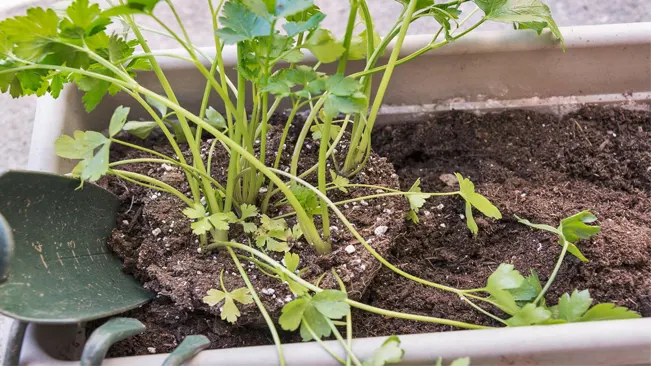
- Importance: Parsley, being a fast-growing herb, can benefit from regular fertilization to replenish nutrients in the soil.
- Type of Fertilizer: An all-purpose liquid fertilizer is ideal as it’s easily absorbed. Choose a balanced formula with equal parts nitrogen, phosphorus, and potassium.
- Frequency: Fertilizing every 4-6 weeks is optimal. This frequency supports continuous growth without over-fertilizing, which can lead to lush foliage but poor flavor.
- Application Tips: Dilute the fertilizer according to the package instructions. Apply it around the base of the plant, avoiding direct contact with the leaves to prevent burn.
Mulching
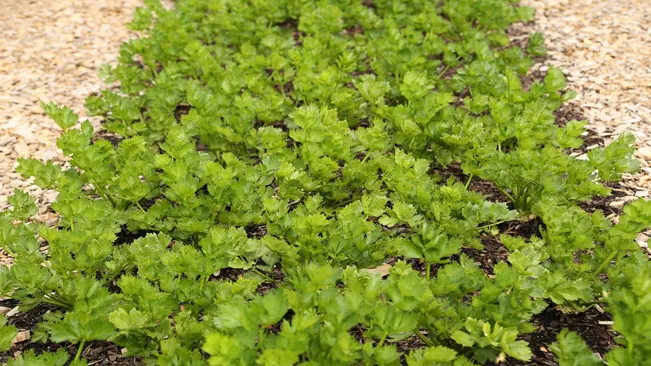
- Purpose: Mulch helps retain soil moisture, which is crucial for parsley’s growth, and it also helps suppress weed growth.
- Types of Mulch: Organic mulch, such as straw, shredded bark, or leaf mold, is preferred. These materials break down over time, adding nutrients to the soil.
- Application: Spread a layer of mulch around the base of the parsley plants, keeping it a few inches away from the stems to prevent rot.
Pruning
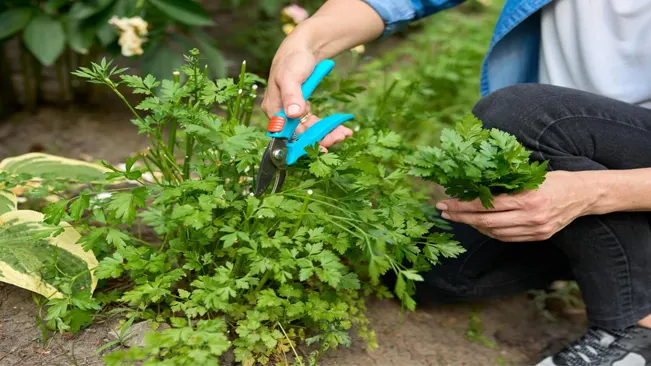
- Encouraging Growth: Regularly snipping off the outer leaves stimulates new growth and helps the plant become bushier.
- Technique: Use sharp scissors or pruning shears to make clean cuts. Snip the stems close to the base of the plant, focusing on the outer, more mature leaves.
- Preventing Bolting: Parsley can bolt (flower and go to seed) in high temperatures or when it’s under stress. Regular pruning can delay or prevent bolting, thereby extending the harvest period.
- Continuous Harvest: By pruning regularly, you can harvest parsley over a long period. Even if you don’t need the leaves, it’s beneficial to prune them to maintain plant health.
Pest and Disease Management
Parsley is relatively pest-free, but watch out for aphids and parsley worms. Organic insecticides or a strong water spray can control aphids. Handpick parsley worms, if they appear.
Pest Management
- Aphids
- Identification: Small, soft-bodied insects that can be green, black, brown, or pink. They often cluster on the undersides of leaves.
- Impact: Aphids suck sap from the plant, causing yellowing and distorted leaves. They also secrete a sticky substance called honeydew, which can lead to sooty mold.
- Control:
- Use a strong water spray to dislodge aphids from the plants.
- Apply organic insecticides like neem oil or insecticidal soap.
- Encourage beneficial insects like ladybugs and lacewings, which are natural predators of aphids.
- Parsley Worms (Black Swallowtail Caterpillars)
- Identification: Green caterpillars with black bands and yellow spots.
- Impact: They feed on the leaves of parsley, which can lead to significant defoliation.
- Control:
- Handpicking is the most effective method. Regularly inspect plants and remove any caterpillars you find.
- Employ natural deterrents like planting pest-repelling flowers nearby.
Disease Management
- Leaf Spot
- Symptoms: Small, brown to black spots on the leaves.
- Prevention & Control:
- Ensure good air circulation.
- Avoid overhead watering to keep the foliage dry.
- Remove and dispose of infected leaves.
- Root Rot
- Symptoms: Yellowing leaves, stunted growth, and decay at the plant base.
- Prevention & Control:
- Provide well-draining soil.
- Avoid overwatering.
- Use raised beds or containers to improve drainage.
- Mildew
- Symptoms: White, powdery substance on the leaves.
- Prevention & Control:
- Improve air circulation.
- Apply fungicides if necessary, following organic gardening practices.
Harvesting and Storage
Harvest parsley as needed, ideally in the morning. Fresh parsley can be stored in the refrigerator wrapped in a damp paper towel or immersed in water. For long-term storage, freeze or dry the leaves.
Harvesting Parsley
When to Harvest
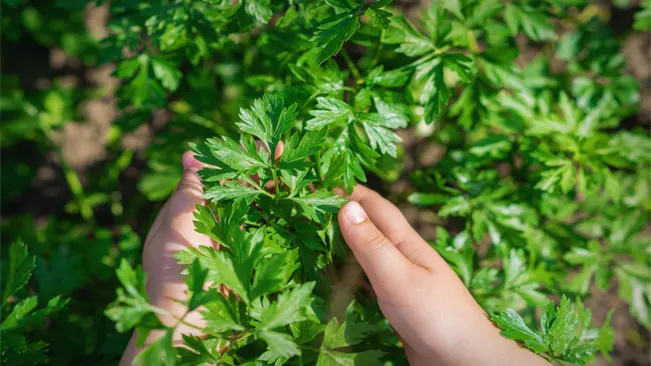
- The best time to harvest parsley is when the plant has several sets of leaves. Usually, this is about 70 to 90 days after planting.
- Morning is ideal for harvesting, as the plants are most hydrated at this time, ensuring the leaves are crisp and full of flavor.
How to Harvest

- Use scissors or garden shears to snip the stems close to the base. This method promotes new growth and helps maintain a bushy, healthy plant.
- Harvest the outer, more mature leaves first, leaving the inner, smaller leaves to grow and mature.
- Regular harvesting prevents the plant from becoming leggy and encourages a continuous supply of fresh leaves.
Storing Fresh Parsley
- Refrigerator Storage
- Wrapped in a Damp Paper Towel: Lay the parsley leaves on a damp paper towel, roll it up gently, and place it in a plastic bag or container in the refrigerator. This method keeps the parsley fresh for about a week.
- In Water: Trim the ends of the stems, place the parsley in a jar with water like a bouquet of flowers, and loosely cover it with a plastic bag. Change the water every couple of days. This method can keep parsley fresh for up to two weeks.
- Freezing
- Blanching Method: Blanch the parsley leaves in boiling water for a few seconds, then plunge them into ice water. Dry them thoroughly, and freeze in a single layer on a baking sheet before transferring to freezer bags.
- Without Blanching: Chop the parsley and pack it into ice cube trays, either alone or mixed with water or oil, and then freeze. Once frozen, transfer the cubes to a freezer bag.
Drying Parsley
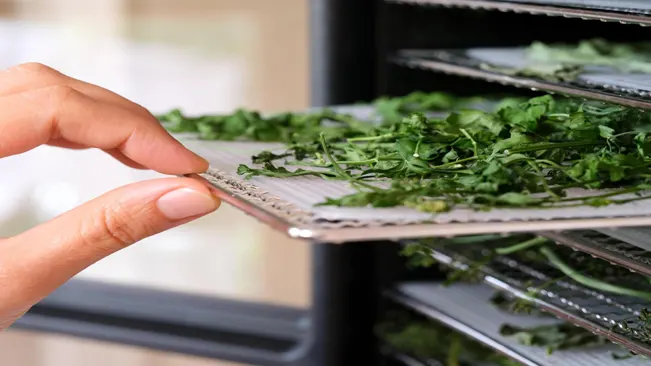
- Air-Drying:
- Tie the stems together and hang them in a warm, airy place away from direct sunlight. Once completely dry, crumble the leaves and store in an airtight container.
- Oven-Drying:
- Place parsley leaves on a baking sheet in a single layer and dry in an oven at a very low temperature (below 100°F or 40°C), with the door slightly ajar to allow moisture to escape. Store in an airtight container once dry.
Tips for Maximum Freshness
- Do not wash parsley before storing as moisture can promote decay. Only wash it right before use.
- If using the water storage method, make sure only the stems are submerged, not the leaves.
- For dried parsley, store in a cool, dark place to maintain flavor and color.
Common Challenges
Slow Germination
- Parsley seeds are notorious for their slow germination process. It can take anywhere from two to six weeks for parsley seeds to sprout. This is often due to the tough seed coat.
Tips to Overcome
- Soak the seeds in warm water for 24 hours before planting to soften the seed coat and accelerate germination.
- Maintain consistent moisture in the soil during the germination period.
- Ensure the planting environment is not too cold; a little warmth can aid in quicker germination.
Overwatering
- While parsley prefers moist soil, overwatering can lead to problems like root rot, a condition where the roots begin to decay in overly wet conditions.

Tips to Overcome
- Water your parsley only when the top inch of the soil feels dry to the touch.
- Improve soil drainage by adding organic matter or sand, especially if you’re dealing with heavy, clay-like soil.
- If growing parsley in containers, ensure the pots have adequate drainage holes.
Bolting
- Bolting is when a plant starts to flower and produce seeds, often leading to a decline in leaf quality. In parsley, this is usually triggered by high temperatures in its second year (as it’s a biennial plant).
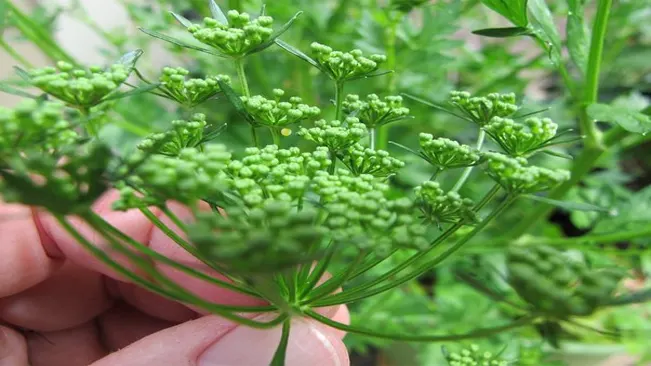
Tips to Overcome
- Harvest parsley leaves regularly. This encourages the plant to produce more foliage and delays bolting.
- Provide some shade during the hottest part of the day, especially in regions with very warm summers.
- If the plant does start to bolt, you can cut back the flowering stems to try and extend its leaf-producing lifespan.
Conclusion
Growing parsley is a delightful and straightforward journey, offering fresh flavors at your fingertips. With patience and care, you can enjoy the lush, aromatic bounty of this versatile herb. Incorporate it into your culinary creations or simply admire its green beauty in your garden – the joys of parsley are endless!
FAQs (Frequently Asked Questions)
- What are the best conditions for growing parsley?
- Parsley thrives in cool to moderate climates, prefers well-drained soil, and needs full to partial sunlight.
- Parsley thrives in cool to moderate climates, prefers well-drained soil, and needs full to partial sunlight.
- How do I plant parsley seeds?
- Soak the seeds overnight to improve germination, plant them ¼ inch deep in soil, and space them about 6 inches apart.
- Soak the seeds overnight to improve germination, plant them ¼ inch deep in soil, and space them about 6 inches apart.
- How long does parsley take to grow?
- Parsley typically takes about 70 to 90 days from planting to reach a harvestable size.
- Parsley typically takes about 70 to 90 days from planting to reach a harvestable size.
- How much water does parsley need?
- Keep the soil moist but not waterlogged. Water parsley when the top inch of soil feels dry.
- Keep the soil moist but not waterlogged. Water parsley when the top inch of soil feels dry.
- Should I use fertilizer for parsley?
- Yes, use a balanced, all-purpose liquid fertilizer every 4-6 weeks.
- Yes, use a balanced, all-purpose liquid fertilizer every 4-6 weeks.
- How do I harvest parsley without harming the plant?
- Snip off the outer leaves at the base of the stem, which encourages new growth and prevents the plant from getting leggy.
- Snip off the outer leaves at the base of the stem, which encourages new growth and prevents the plant from getting leggy.
- Can I grow parsley indoors?
- Yes, parsley can be grown indoors near a sunny window or under grow lights.
- Yes, parsley can be grown indoors near a sunny window or under grow lights.
- What are common pests that affect parsley, and how do I deal with them?
- Aphids and parsley worms are common. Use organic insecticides or a strong water spray for aphids, and handpick parsley worms.
- Aphids and parsley worms are common. Use organic insecticides or a strong water spray for aphids, and handpick parsley worms.
- How do I store harvested parsley?
- Fresh parsley can be stored in the refrigerator wrapped in a damp paper towel or immersed in water. You can also dry or freeze it for long-term storage.
- Fresh parsley can be stored in the refrigerator wrapped in a damp paper towel or immersed in water. You can also dry or freeze it for long-term storage.
- Can parsley be grown in pots?
- Yes, parsley grows well in pots. Ensure the pot has drainage holes and is deep enough to accommodate the long roots.
For more expert gardening advice, explore our guides, discover top recommendations in our best section, and delve into in-depth product reviews in our review section.

Kristine Moore
Forestry AuthorI'm Kristine Moore, a seasoned garden landscaping professional with over 30 years of experience. My extensive career has been dedicated to transforming outdoor spaces into stunning, sustainable landscapes. With a deep understanding of horticulture, design principles, and environmental stewardship, I have become a respected figure in the field, known for creating harmonious, visually appealing, and eco-friendly gardens. My commitment to excellence and continuous learning in landscaping trends and techniques has solidified my reputation as an expert in garden design and implementation.

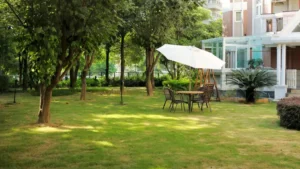








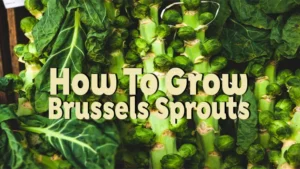
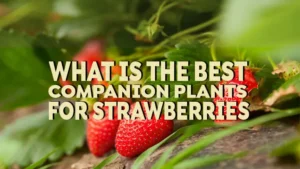
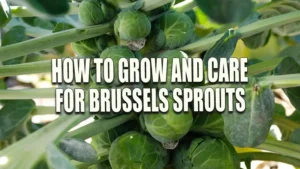
Leave your comment